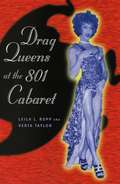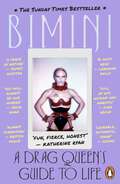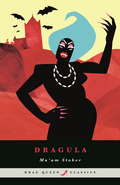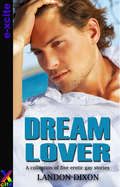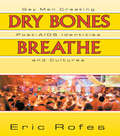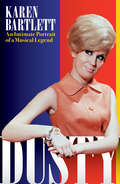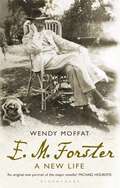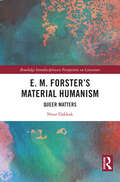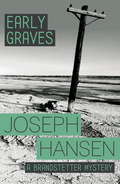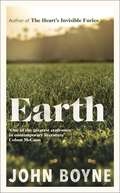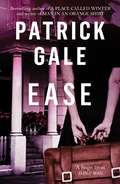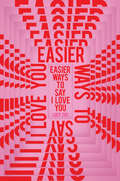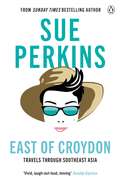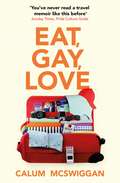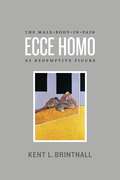- Table View
- List View
Drag Queens at the 801 Cabaret
by Leila J. Rupp Verta TaylorIt's Saturday night in Key West and the Girlie Show is about to begin at the 801 Cabaret. The girls have been outside on the sidewalk all evening, seducing passersby into coming in for the show. The club itself is packed tonight and smoke has filled the room. When the lights finally go down, statuesque blonds and stunning brunettes sporting black leather miniskirts, stiletto heels, and see-through lingerie take the stage. En Vogue's "Free Your Mind" blares on the house stereo. The crowd roars in approval. In this lively book, Leila J. Rupp and Verta Taylor take us on an entertaining tour through one of America's most overlooked subcultures: the world of the drag queen. They offer a penetrating glimpse into the lives of the 801 Girls, the troupe of queens who perform nightly at the 801 Cabaret for tourists and locals. Weaving together their fascinating life stories, their lavish costumes and eclectic music, their flamboyance and bitchiness, and their bawdy exchanges with one another and their audiences, the authors explore how drag queens smash the boundaries between gay and straight, man and woman, to make people think more deeply and realistically about sex and gender in America today. They also consider how the queens create a space that encourages camaraderie and acceptance among everyday people, no matter what their sexual preferences might be. Based on countless interviews with more than a dozen drag queens, more than three years of attendance at their outrageous performances, and even the authors' participation in the shows themselves, Drag Queens at the 801 Cabaret is a witty and poignant portrait of gay life and culture. When they said life is a cabaret, they clearly meant the 801.
Drag Queens at the 801 Cabaret
by Leila J. Rupp Verta TaylorIt's Saturday night in Key West and the Girlie Show is about to begin at the 801 Cabaret. The girls have been outside on the sidewalk all evening, seducing passersby into coming in for the show. The club itself is packed tonight and smoke has filled the room. When the lights finally go down, statuesque blonds and stunning brunettes sporting black leather miniskirts, stiletto heels, and see-through lingerie take the stage. En Vogue's "Free Your Mind" blares on the house stereo. The crowd roars in approval. In this lively book, Leila J. Rupp and Verta Taylor take us on an entertaining tour through one of America's most overlooked subcultures: the world of the drag queen. They offer a penetrating glimpse into the lives of the 801 Girls, the troupe of queens who perform nightly at the 801 Cabaret for tourists and locals. Weaving together their fascinating life stories, their lavish costumes and eclectic music, their flamboyance and bitchiness, and their bawdy exchanges with one another and their audiences, the authors explore how drag queens smash the boundaries between gay and straight, man and woman, to make people think more deeply and realistically about sex and gender in America today. They also consider how the queens create a space that encourages camaraderie and acceptance among everyday people, no matter what their sexual preferences might be. Based on countless interviews with more than a dozen drag queens, more than three years of attendance at their outrageous performances, and even the authors' participation in the shows themselves, Drag Queens at the 801 Cabaret is a witty and poignant portrait of gay life and culture. When they said life is a cabaret, they clearly meant the 801.
Drag Queens at the 801 Cabaret
by Leila J. Rupp Verta TaylorIt's Saturday night in Key West and the Girlie Show is about to begin at the 801 Cabaret. The girls have been outside on the sidewalk all evening, seducing passersby into coming in for the show. The club itself is packed tonight and smoke has filled the room. When the lights finally go down, statuesque blonds and stunning brunettes sporting black leather miniskirts, stiletto heels, and see-through lingerie take the stage. En Vogue's "Free Your Mind" blares on the house stereo. The crowd roars in approval. In this lively book, Leila J. Rupp and Verta Taylor take us on an entertaining tour through one of America's most overlooked subcultures: the world of the drag queen. They offer a penetrating glimpse into the lives of the 801 Girls, the troupe of queens who perform nightly at the 801 Cabaret for tourists and locals. Weaving together their fascinating life stories, their lavish costumes and eclectic music, their flamboyance and bitchiness, and their bawdy exchanges with one another and their audiences, the authors explore how drag queens smash the boundaries between gay and straight, man and woman, to make people think more deeply and realistically about sex and gender in America today. They also consider how the queens create a space that encourages camaraderie and acceptance among everyday people, no matter what their sexual preferences might be. Based on countless interviews with more than a dozen drag queens, more than three years of attendance at their outrageous performances, and even the authors' participation in the shows themselves, Drag Queens at the 801 Cabaret is a witty and poignant portrait of gay life and culture. When they said life is a cabaret, they clearly meant the 801.
Drag Queens at the 801 Cabaret
by Leila J. Rupp Verta TaylorIt's Saturday night in Key West and the Girlie Show is about to begin at the 801 Cabaret. The girls have been outside on the sidewalk all evening, seducing passersby into coming in for the show. The club itself is packed tonight and smoke has filled the room. When the lights finally go down, statuesque blonds and stunning brunettes sporting black leather miniskirts, stiletto heels, and see-through lingerie take the stage. En Vogue's "Free Your Mind" blares on the house stereo. The crowd roars in approval. In this lively book, Leila J. Rupp and Verta Taylor take us on an entertaining tour through one of America's most overlooked subcultures: the world of the drag queen. They offer a penetrating glimpse into the lives of the 801 Girls, the troupe of queens who perform nightly at the 801 Cabaret for tourists and locals. Weaving together their fascinating life stories, their lavish costumes and eclectic music, their flamboyance and bitchiness, and their bawdy exchanges with one another and their audiences, the authors explore how drag queens smash the boundaries between gay and straight, man and woman, to make people think more deeply and realistically about sex and gender in America today. They also consider how the queens create a space that encourages camaraderie and acceptance among everyday people, no matter what their sexual preferences might be. Based on countless interviews with more than a dozen drag queens, more than three years of attendance at their outrageous performances, and even the authors' participation in the shows themselves, Drag Queens at the 801 Cabaret is a witty and poignant portrait of gay life and culture. When they said life is a cabaret, they clearly meant the 801.
Drag Queens at the 801 Cabaret
by Leila J. Rupp Verta TaylorIt's Saturday night in Key West and the Girlie Show is about to begin at the 801 Cabaret. The girls have been outside on the sidewalk all evening, seducing passersby into coming in for the show. The club itself is packed tonight and smoke has filled the room. When the lights finally go down, statuesque blonds and stunning brunettes sporting black leather miniskirts, stiletto heels, and see-through lingerie take the stage. En Vogue's "Free Your Mind" blares on the house stereo. The crowd roars in approval. In this lively book, Leila J. Rupp and Verta Taylor take us on an entertaining tour through one of America's most overlooked subcultures: the world of the drag queen. They offer a penetrating glimpse into the lives of the 801 Girls, the troupe of queens who perform nightly at the 801 Cabaret for tourists and locals. Weaving together their fascinating life stories, their lavish costumes and eclectic music, their flamboyance and bitchiness, and their bawdy exchanges with one another and their audiences, the authors explore how drag queens smash the boundaries between gay and straight, man and woman, to make people think more deeply and realistically about sex and gender in America today. They also consider how the queens create a space that encourages camaraderie and acceptance among everyday people, no matter what their sexual preferences might be. Based on countless interviews with more than a dozen drag queens, more than three years of attendance at their outrageous performances, and even the authors' participation in the shows themselves, Drag Queens at the 801 Cabaret is a witty and poignant portrait of gay life and culture. When they said life is a cabaret, they clearly meant the 801.
Drag Queens at the 801 Cabaret
by Leila J. Rupp Verta TaylorIt's Saturday night in Key West and the Girlie Show is about to begin at the 801 Cabaret. The girls have been outside on the sidewalk all evening, seducing passersby into coming in for the show. The club itself is packed tonight and smoke has filled the room. When the lights finally go down, statuesque blonds and stunning brunettes sporting black leather miniskirts, stiletto heels, and see-through lingerie take the stage. En Vogue's "Free Your Mind" blares on the house stereo. The crowd roars in approval. In this lively book, Leila J. Rupp and Verta Taylor take us on an entertaining tour through one of America's most overlooked subcultures: the world of the drag queen. They offer a penetrating glimpse into the lives of the 801 Girls, the troupe of queens who perform nightly at the 801 Cabaret for tourists and locals. Weaving together their fascinating life stories, their lavish costumes and eclectic music, their flamboyance and bitchiness, and their bawdy exchanges with one another and their audiences, the authors explore how drag queens smash the boundaries between gay and straight, man and woman, to make people think more deeply and realistically about sex and gender in America today. They also consider how the queens create a space that encourages camaraderie and acceptance among everyday people, no matter what their sexual preferences might be. Based on countless interviews with more than a dozen drag queens, more than three years of attendance at their outrageous performances, and even the authors' participation in the shows themselves, Drag Queens at the 801 Cabaret is a witty and poignant portrait of gay life and culture. When they said life is a cabaret, they clearly meant the 801.
A Drag Queen's Guide to Life: A Drag Queen's Guide To Life
by Bimini Bon Boulash'MAGIC! A fun, fierce, honest origin story of how to drag yourself up out of trouble and become an icon' Katherine Ryan 'A triumph for UK queer culture' Travis Alabanza 'Eye-opening, intelligent, thoughtful as well as sassy and surprising - a must read' Lorraine Kelly _______________________________________ A witty and inspiring guide to transforming your life through lessons from drag, by the UK's favourite drag queen and star of RuPaul's Drag Race UK, Bimini Bon Boulash.From being told she couldn't have dance lessons as a kid in Great Yarmouth to having to conform to the stereotypes of the gay scene in London's East End, people have always been trying to put Bimini Bon Boulash in a box. It was only through discovering the art of drag that she began to fight back against those preconceptions, and understand that she had the power to define herself.In A Drag Queen's Guide to Life, Bimini tells the story of how drag took her from the brink of self-destruction to become a gag-inducing, death-dropping, plant-based superstar. Drawing on her own experience as a nonbinary person in a binary world, as well as inspirational stories from history, politics, pop culture and fashion, she uses all her wit, charm and kindness to show us how to lead the lives we wish we could lead, through the life-changing magic of dragging up. _______________________________________ 'Radical, life-affirming, and utterly important for this time' Riyadh Khalaf 'A very important read' Gottmik 'She's a superstar' Kathy Burke 'You will always be our winner' Sadiq Khan, Mayor of London 'A force of nature' James Acaster
Dragula
by Ma'am StokerIn a land where the wolves howl 'yassss kween' and Bloody Marys are the only cocktail on offer, Jonathan Harker (a most basic b*tch) makes a series of horrifying discoveries at the House of Dragula. A battle between old queens draws fresh blood as the VAMPageant grudge match looms closer. Will Dragula defeat the infamous Van High Heelsing? Will a new protege werk the cape? Will the old bat ever learn to contour? It's all to play for as these classic characters step out of the shadows and into the shade for a tale of unflinching death drops and the ultimate lip sync for your (after) life.
Dream Lover: A collection of five gay erotic short stories (Hot Tales of Gay Lust #5)
by Landon DixonA collection of five erotic gay stories with explicit male on male action by Landon Dixon.Shadow Over Southdale: 'He thought no one was watching. He thought wrong.' There was a man up in the tree overlooking Leneal Thompson's backyard, as the studly guy stretched out and started jacking his donkey-dong. Voyeurism was running rampant in the Southdale subdivision, and that called for action - man-on-man action, up-close and personal.False Fronts: Dick Polk, Hollywood PI. The dirtiest dick of the dirty thirties, willing to do almost anything to crack a case, or an ass. In this case, a movie extra swish name of Lavinder Folles hires him to find heel Tex Rodeo (a/k/a Dagskiell Goodmunderson), a fellow bit-part shadow player who's stolen Lavinder's heart - five hundred dollars cash, a pet snake, and 'Grandma's pearl'. The investigation leads Polk to a sweat-soaked marathon dance at Long Beach, where some of the contestants prove as phony as the prize money promised. Just like Hollywood facades are packed with false promise.Stickhandling: They'd snagged third place in the hockey tournament that afternoon, were flying back to the States the following morning - and from there they'd disperse to their various college teams in the northern US. That meant tonight was the last chance for one smooth-skating finesse player to put the moves on his room and teammate Matt, the hard-checking puck hunk who might play the same game, or not. So, what was the game plan, that didn't result in teeth going missing?Troublemaker: Travis just can't stay out of trouble. Whether it's a solo handjob in a truck stop, a drive-by blowjob, or a lakefront butt-fuck; trouble just seems to follow him around. As he flees from the scene of his first great sex - in a hot tub with his one true love, the presumed drowned Donnie.Dream Lover: It was a fetish: watching men sleep, kissing them, licking them, fondling them, fucking them while they sleep. Mancolepsy. Only, two can play at that game. Who says dreams don't come true?These stories have also been published in Hot Tales of Gay Lust Two 9781908192462
Dry Bones Breathe: Gay Men Creating Post-AIDS Identities and Cultures
by Eric RofesDry Bones Breathe: Gay Men Creating Post-AIDS Identities and Cultures breaks new ground in offering an original and insightful interpretation of gay men’s shifting experience of the AIDS epidemic. From Dry Bones Breathe, you’ll gain a deeper understanding of current community debates focused on circuit parties, unprotected sex, and gay men’s sexual cultures, and you will learn how social, political, and biomedical changes are dramatically transforming gay identities and cultures.Dry Bones Breathe is Eric Rofes’explosive follow-up to Reviving the Tribe, a book which broke open debates in gay communities around the world about sex, identity, and gay men’s relationship to AIDS. In this volume, Rofes contends that most gay men no longer experience AIDS as the crisis they did during the 1980s. Gay men often attribute this shift to the advent of protozoa inhibitors, but Rofes explains how other factors, including the epidemic’s predicted trajectory, new treatments for opportunistic infections, the passage of time, and the increasing diversity of gay men inhabiting communities throughout the country have set in motion the transformation of gay life. AIDS organizations and gay leaders, however, continue to assert that gay men experience AIDS as an emergency, resulting in a tremendous dissonance between gay leaders and their communities. In the midst of this controversy, Dry Bones Breathe lets you share in stories of hope and recovery and a new vision for AIDS work that demands a radical redesign of prevention, care, and activism. Dry Bones Breathe tackles several other issues concerning the powerful shifts occurring in gay communities and cultures by: explaining why an understanding of the terms “post-AIDS” and “post-crisis” is crucial to interpreting contemporary gay male cultures and what Australian prevention theorists have to offer gay men in the United States describing the “Protozoa Moment” and exploring how a dangerous obsession with pharmaceuticals is leading many to mistakenly attribute all changes in gay men’s cultures to combination therapies examining the writings of Larry Kramer, Andrew Sullivan, Michelangelo Signorile, and Gabriel Rightly to illustrate how the crisis construct has unleashed a backlash against gay sexual cultures discussing the dramatic diminution in gay men’s AIDS-related deaths in epicenter cities and the impact of shrinking obituary pages on gay men’s mental health exploring the diverse relationships to the epidemic forged by young gay men, gay men of color, gay men from rural or small towns, and middle-aged men not infected with HI detailing how HI prevention and service organizations targeting gay men must redesign their mission and restructure their work In response to continuing efforts to direct gay men back into a state of emergency, Dry Bones Breathe suggests that long-term prevention efforts must be constructed around something other than a crisis. While AIDS organizations look at gay men’s diminished participation in AIDS activism, Rofes argues that these organizations should face how they have distanced themselves from the reality of most gay men’s lives. From stories and experiences full of hope, anger, sadness, and strength, Dry Bones Breathe will teach you about gay men who no longer base their identities and cultures solely around AIDS.
Dry Bones Breathe: Gay Men Creating Post-AIDS Identities and Cultures
by Eric RofesDry Bones Breathe: Gay Men Creating Post-AIDS Identities and Cultures breaks new ground in offering an original and insightful interpretation of gay men’s shifting experience of the AIDS epidemic. From Dry Bones Breathe, you’ll gain a deeper understanding of current community debates focused on circuit parties, unprotected sex, and gay men’s sexual cultures, and you will learn how social, political, and biomedical changes are dramatically transforming gay identities and cultures.Dry Bones Breathe is Eric Rofes’explosive follow-up to Reviving the Tribe, a book which broke open debates in gay communities around the world about sex, identity, and gay men’s relationship to AIDS. In this volume, Rofes contends that most gay men no longer experience AIDS as the crisis they did during the 1980s. Gay men often attribute this shift to the advent of protozoa inhibitors, but Rofes explains how other factors, including the epidemic’s predicted trajectory, new treatments for opportunistic infections, the passage of time, and the increasing diversity of gay men inhabiting communities throughout the country have set in motion the transformation of gay life. AIDS organizations and gay leaders, however, continue to assert that gay men experience AIDS as an emergency, resulting in a tremendous dissonance between gay leaders and their communities. In the midst of this controversy, Dry Bones Breathe lets you share in stories of hope and recovery and a new vision for AIDS work that demands a radical redesign of prevention, care, and activism. Dry Bones Breathe tackles several other issues concerning the powerful shifts occurring in gay communities and cultures by: explaining why an understanding of the terms “post-AIDS” and “post-crisis” is crucial to interpreting contemporary gay male cultures and what Australian prevention theorists have to offer gay men in the United States describing the “Protozoa Moment” and exploring how a dangerous obsession with pharmaceuticals is leading many to mistakenly attribute all changes in gay men’s cultures to combination therapies examining the writings of Larry Kramer, Andrew Sullivan, Michelangelo Signorile, and Gabriel Rightly to illustrate how the crisis construct has unleashed a backlash against gay sexual cultures discussing the dramatic diminution in gay men’s AIDS-related deaths in epicenter cities and the impact of shrinking obituary pages on gay men’s mental health exploring the diverse relationships to the epidemic forged by young gay men, gay men of color, gay men from rural or small towns, and middle-aged men not infected with HI detailing how HI prevention and service organizations targeting gay men must redesign their mission and restructure their work In response to continuing efforts to direct gay men back into a state of emergency, Dry Bones Breathe suggests that long-term prevention efforts must be constructed around something other than a crisis. While AIDS organizations look at gay men’s diminished participation in AIDS activism, Rofes argues that these organizations should face how they have distanced themselves from the reality of most gay men’s lives. From stories and experiences full of hope, anger, sadness, and strength, Dry Bones Breathe will teach you about gay men who no longer base their identities and cultures solely around AIDS.
Dusty: An Intimate Portrait of a Musical Legend
by Karen BartlettKnown the world over for her unique musical style, distinctive look and a voice that propelled her into the charts time and time again, Dusty Springfield was undoubtedly one of the biggest and brightest musical stars of the twentieth century. Never one to be shy of the spotlight, Dusty broke the mould as the first female entertainer to publicly admit she was bisexual, and was famously deported from South Africa for refusing to play to segregated audiences during apartheid in 1964, just a year after the launch of her solo career. Combining brand-new material, meticulous research and frank interviews with friends, lovers, employees and confidants, journalist Karen Bartlett reveals sensational new details about the soul diva's unconventional upbringing, tumultuous relationships and unbridled addictions, including a lifelong struggle to come to terms with her sexuality. Named one of the Sunday Times's best musical biographies of 2014, this is the intimate portrait of an immensely complicated and talented woman - the definitive account of one of music's most legendary figures.
E. M. Forster: A New Life
by Wendy MoffatOne of the great mysteries in the life of E. M. Forster (1879-1970) is why, after the publication of A Passage to India in 1924, he never published another novel although he lived to be 90. In Wendy Moffat's biography, based on a lifetime's dedication to her subject, we gain extraordinary insights into a man with a gift for writing fiction of great humanity, warmth and humour, who realised early that the society of his time would not allow him to publish the fiction he really wanted to write. At the end of A Passage to India, his readers were left with the melancholy sight of Aziz and Fielding, friends of different races and cultures, riding out of the novel down separate paths. In real life, although frustrated at not being able to write out of his true self - it would not be until after his death that Maurice, his novel of a homosexual affair, would be published - E. M.Forster led a full and energetic life. He was a successful broadcaster, a brilliant essayist (Abinger Harvest and Two Cheers for Democracy are still must-reads) and a leading figure in Europe's intellectual life. Moffat argues that with his support for colleagues from Lowes Dickinson and Radclyffe Hall to Christopher Isherwood and Benjamin Britten, and his quiet championing of humanistic values, he helped create the more tolerant world we now enjoy.Moffat's achievement is not to show that Forster was homosexual (this is well known) but how deeply his ideas on individual freedom, tolerance, sexuality and love, permeated every act and aspect of his life.
E. M. Forster’s Material Humanism: Queer Matters (Routledge Interdisciplinary Perspectives on Literature)
by Nour DakkakThrough attending to the nonhuman, E. M. Forster’s Material Humanism: Queer Matters places Forster’s fiction in conversation with contemporary debates concerned with the intersection of neomaterialism, environmental humanities and queer ecology. The book revisits Forster’s liberal humanism from a materialist perspective by focusing on humans’ embodied activities in artificial and natural environments. By examining the everyday embodied experiences of characters, the book thus brings to the fore insignificant and sometimes overlooked aspects in Forster’s fiction. It also places importance on the texts’ treatment of queer intimacy as an embodied experience that can transcend sexual desire. The book acknowledges nonhuman agency as central to our understanding of queerness in Forster’s texts and studies the representation of formless matters such as dust as a way through which Forster’s ecological concerns arise by linking the fate of oppressed humans with oppressed nonhuman others.
E. M. Forster’s Material Humanism: Queer Matters (Routledge Interdisciplinary Perspectives on Literature)
by Nour DakkakThrough attending to the nonhuman, E. M. Forster’s Material Humanism: Queer Matters places Forster’s fiction in conversation with contemporary debates concerned with the intersection of neomaterialism, environmental humanities and queer ecology. The book revisits Forster’s liberal humanism from a materialist perspective by focusing on humans’ embodied activities in artificial and natural environments. By examining the everyday embodied experiences of characters, the book thus brings to the fore insignificant and sometimes overlooked aspects in Forster’s fiction. It also places importance on the texts’ treatment of queer intimacy as an embodied experience that can transcend sexual desire. The book acknowledges nonhuman agency as central to our understanding of queerness in Forster’s texts and studies the representation of formless matters such as dust as a way through which Forster’s ecological concerns arise by linking the fate of oppressed humans with oppressed nonhuman others.
Early Graves: Dave Brandstetter Investigation 9 (Dave Brandstetter #9)
by Joseph Hansen'After forty years, Hammett has a worthy successor' The TimesDave Brandstetter stands alongside Philip Marlowe, Sam Spade and Lew Archer as one of the best fictional PIs in the business. Like them, he was tough, determined, and ruthless when the case demanded it. Unlike them, he was gay. Joseph Hansen's groundbreaking novels follow Brandstetter as he investigates cases in which motives are murky, passions run high, and nothing is ever as simple as it looks. Set in 1970s and 80s California, the series is a fascinating portrait of a time and a place, with mysteries to match Chandler and Macdonald.Dave returns home one morning to find an unknown dead man in his front yard, the latest victim of a serial killer targeting young men with AIDS. Why was he brought to Dave's door? The hunt for the answer leads him from the country set to the downtown hustlers, along the dark byways of sex, suffering, grief and vengeance.
Earth: from the author of The Heart’s Invisible Furies
by John Boyne'Compelling... a potent portrait of a flawed young man' Daily Mail'A strong set-up, and with the masterly Boyne at the helm, the tension never lets up' Mail on Sunday_____________From million-copy-bestselling author John Boyne, an inescapably gritty story about one young man whose direction in life takes a vastly different turn than what he expected.It’s the tabloid sensation of the year: two well-known footballers standing in the dock, charged with sexual assault, a series of vile text messages pointing towards their guilt.As the trial unfolds, Evan Keogh reflects on the events that have led him to this moment. Since leaving his island home, his life has been a lie on many levels. He’s a talented footballer who wanted to be an artist. A gay man in a sport that rejects diversity. A defendant whose knowledge of what took place on that fateful night threatens more than just his freedom or career.The jury will deliver a verdict but, before they do, Evan must judge for himself whether the man he has become is the man he wanted to be.___________What readers are saying about Earth:'I read it in one sitting''I devoured this book''Unputdownable''Beautifully written and compelling''A short, sharp read... hard to tear your eyes away'
Ease: A Novel
by Patrick GaleA quirky, warm novel of eccentric adventure from the bestselling author of A PLACE CALLED WINTER - 'A huge treat' Daily Mail'Patrick Gale is among the great, unsung English novelists. Think Austen, Hardy, Murdoch. Remarkable' IndependentDomina Tey is a playwright, celebrated by friends, her husband, and the public alike, yet she fears losing her vital edge. Her solution: to leave her beautiful home in Bristol and seek adventure in a squalid West London bedsit, where she will live under an assumed name with only her typewriter for companionship. Once installed, however, she can't resist meddling in the business of others, forgetting that blurring fact with fiction can be a dangerous game.
Easier Ways to Say I Love You
by Lucy FryA memoir on love, lust and attachment: one woman’s remarkable and candid account of transforming a difficult and uncomfortable love triangle into an honest polyamorous relationship.Lucy Fry’s story opens with the heady and impassioned affair she embarked on during her wife’s pregnancy. It is a relationship that appears to be unstoppable, perhaps even addictive, despite guilt and self questioning. With intense and unflinching honesty, she takes us on a compelling journey from childhood trauma and addiction to sobriety, from infidelity to ethical non-monogamy, and—perhaps most intensely of all—from her fear of parenthood to her exquisite joy at having a son.L and B’s love for their new baby, ‘The Boy’, changes the dynamic once again. They fumble through early parenthood, in a way that many will recognise, while at the same time trying to fathom and fashion a unique journey of their own.
East of Croydon: Blunderings through India and South East Asia
by Sue PerkinsSue Perkins has ventured far and wide to bring you her brand new book. Pre order your copy now . . . _________A few years ago I was asked if I'd like to make a documentary on the Mekong River, travelling from the vast delta in Vietnam to the remote and snowy peaks of Tibet. Up until that point, the farthest East I'd been was Torremolinos, in the Costa Del Sol. Here's the thing: I am scared of flying. I have zero practical skills. I can't survive if I am more than a three minute walk from a supermarket. For the last seven years I have suffered with crippling anxiety I bolt when panicked. I cannot bear to witness humans or animals in distress I have no ability to learn languages. I am a terrible hypochondriac Oh, and I am no good with boats. So I said yes. _________ PRAISE FOR SUE PERKINS 'Drama, tears and laughs ... I ADORED it' Jessie Burton, bestselling author of The Miniaturist 'Very funny ... reading her memoir is very like meeting her' Sunday Times 'Charming and funny .... Like going for a long, slightly drunken lunch with your naughtiest friend' Red 'Brilliantly written... fearlessly honest and full of heart, it will also make you laugh like a gibbon' Heat I absolutely loved it . . . whip smart and very funny' Woman & Home 'Warm, crisp and beautifully layered ... a complete delight' Independent on Sunday 'Deftly written and belly-laugh funny' Express 'Honest, warm and downright hilarious' OK 'Utterly wonderful. It's very, very funny and poignant and it's very Sue Perkins and that's the bliss of it' Nina Stibbe, bestselling author of Love, Nina
Eat, Gay, Love: A Memoir
by Calum McSwigganIn the spring of 2012, Calum finds himself single again after his relationship of six years comes to an end. Heartbroken, unhappy and unsure of what to do next, he leaves the hometown he has been in all his life to embark on a journey that takes him all around the world, from teaching in a school on the outskirts of Rome to exploring the sex clubs of Berlin, to raising tigers in an animal sanctuary deep in the jungles of Thailand. Along the way, he meets LGBT+ people from all walks of life and every part of the rainbow - from an Italian teenager struggling with a homophobic father to a kathoey navigating life as a trans person in Thailand, to a young HIV-positive man living on the streets of London. Their individual stories, not only of hardship and sorrow but also of profound strength and hope, show the breadth and depth of queer life and experience, shedding light on themes such as homophobia, sexual violence, marriage equality and gender identity. Through these meetings and friendships, Calum not only finds the encouragement to embrace life after heartbreak, but also discovers a beautiful, loving global community who support and uplift him through the best and worst moments of his time on the road. A travel memoir with a difference, Eat, Gay, Love is a celebration of the power of community and a personal tribute to the extraordinary lives of LGBT+ people everywhere in the world.
Ecce Homo: The Male-Body-in-Pain as Redemptive Figure
by Kent L. BrintnallImages of suffering male bodies permeate Western culture, from Francis Bacon’s paintings and Robert Mapplethorpe’s photographs to the battered heroes of action movies. Drawing on perspectives from a range of disciplines—including religious studies, gender and queer studies, psychoanalysis, art history, and film theory—Ecce Homo explores the complex, ambiguous meanings of the enduring figure of the male-body-in-pain. Acknowledging that representations of men confronting violence and pain can reinforce ideas of manly tenacity, Kent L. Brintnall also argues that they reveal the vulnerability of men’s bodies and open them up to eroticization. Locating the roots of our cultural fascination with male pain in the crucifixion, he analyzes the way narratives of Christ’s death and resurrection both support and subvert cultural fantasies of masculine power and privilege. Through stimulating readings of works by Georges Bataille, Kaja Silverman, and more, Brintnall delineates the redemptive power of representations of male suffering and violence.
Ecce Homo: The Male-Body-in-Pain as Redemptive Figure
by Kent L. BrintnallImages of suffering male bodies permeate Western culture, from Francis Bacon’s paintings and Robert Mapplethorpe’s photographs to the battered heroes of action movies. Drawing on perspectives from a range of disciplines—including religious studies, gender and queer studies, psychoanalysis, art history, and film theory—Ecce Homo explores the complex, ambiguous meanings of the enduring figure of the male-body-in-pain. Acknowledging that representations of men confronting violence and pain can reinforce ideas of manly tenacity, Kent L. Brintnall also argues that they reveal the vulnerability of men’s bodies and open them up to eroticization. Locating the roots of our cultural fascination with male pain in the crucifixion, he analyzes the way narratives of Christ’s death and resurrection both support and subvert cultural fantasies of masculine power and privilege. Through stimulating readings of works by Georges Bataille, Kaja Silverman, and more, Brintnall delineates the redemptive power of representations of male suffering and violence.
Ecce Homo: The Male-Body-in-Pain as Redemptive Figure
by Kent L. BrintnallImages of suffering male bodies permeate Western culture, from Francis Bacon’s paintings and Robert Mapplethorpe’s photographs to the battered heroes of action movies. Drawing on perspectives from a range of disciplines—including religious studies, gender and queer studies, psychoanalysis, art history, and film theory—Ecce Homo explores the complex, ambiguous meanings of the enduring figure of the male-body-in-pain. Acknowledging that representations of men confronting violence and pain can reinforce ideas of manly tenacity, Kent L. Brintnall also argues that they reveal the vulnerability of men’s bodies and open them up to eroticization. Locating the roots of our cultural fascination with male pain in the crucifixion, he analyzes the way narratives of Christ’s death and resurrection both support and subvert cultural fantasies of masculine power and privilege. Through stimulating readings of works by Georges Bataille, Kaja Silverman, and more, Brintnall delineates the redemptive power of representations of male suffering and violence.
Ecce Homo: The Male-Body-in-Pain as Redemptive Figure
by Kent L. BrintnallImages of suffering male bodies permeate Western culture, from Francis Bacon’s paintings and Robert Mapplethorpe’s photographs to the battered heroes of action movies. Drawing on perspectives from a range of disciplines—including religious studies, gender and queer studies, psychoanalysis, art history, and film theory—Ecce Homo explores the complex, ambiguous meanings of the enduring figure of the male-body-in-pain. Acknowledging that representations of men confronting violence and pain can reinforce ideas of manly tenacity, Kent L. Brintnall also argues that they reveal the vulnerability of men’s bodies and open them up to eroticization. Locating the roots of our cultural fascination with male pain in the crucifixion, he analyzes the way narratives of Christ’s death and resurrection both support and subvert cultural fantasies of masculine power and privilege. Through stimulating readings of works by Georges Bataille, Kaja Silverman, and more, Brintnall delineates the redemptive power of representations of male suffering and violence.
